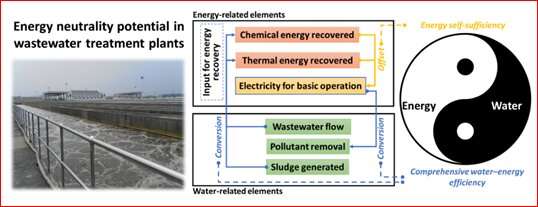Credit: DOI: 10.1007/s11783-022-1549-0
Toward China's carbon neutrality goals, it is necessary to consider wastewater treatment plants. Such municipal facilities consume huge amounts of energy and emit greenhouse gases to remove pollutants. The main three pathways for decarbonization of the plants include energy reduction, energy recovery, and energy renewables. Energy neutrality would be primary to the carbon issues for the wastewater treatment facility.
Hongtao Wang and his research group in Tongji University proposed a framework for evaluating wastewater treatment plants from an integrated perspective in the study, which was published in Frontiers of Environmental Science & Engineering on Feb. 14, 2022. Two indicators were established based on the initial variables of wastewater, sludge, and energy inside the plants. The first indicator is energy self-sufficiency that reflects the offset degree of energy recovery. The second one is comprehensive water-energy efficiency which characterizes the efficiency of bidirectional conversion between water and energy in the plants. Based on this, the energy neutrality potential of plants was defined and assessed.
Hongtao says, "The study area was the Yangtze River Economic Belt, which is an important area in China. We have extracted the operational data of 970 wastewater treatment plants in this area from the China Urban Drainage Yearbook 2018. There were 98 samples identified as energy benchmark, while 112 plants could be fully energy self-sufficient."
Hongtao and his group will continue to work on the water-energy-carbon issues of wastewater treatment plants. Hongtao hopes to further predict the future trend and provide realistic optimization strategies for full-scale wastewater treatment plants. "Multi-source data collection and project validation will be carried out," Hongtao says.
More information: Runyao Huang et al, Energy neutrality potential of wastewater treatment plants: A novel evaluation framework integrating energy efficiency and recovery, Frontiers of Environmental Science & Engineering (2022). DOI: 10.1007/s11783-022-1549-0
Provided by Higher Education Press
























